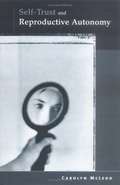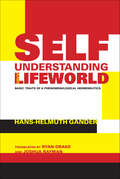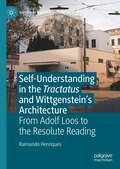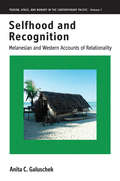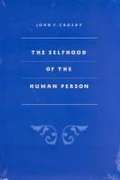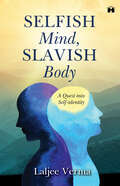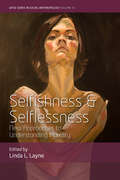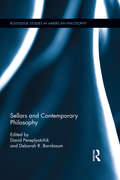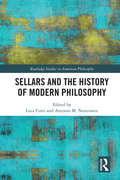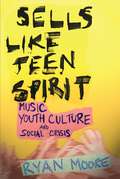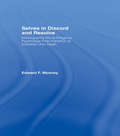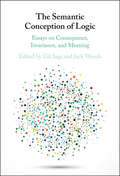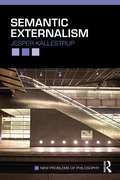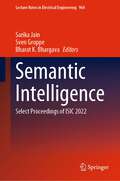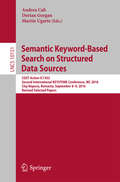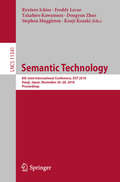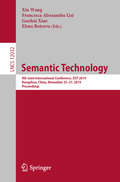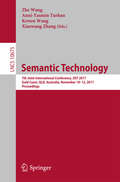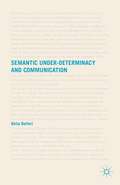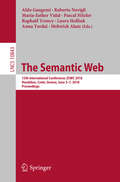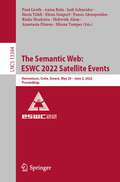- Table View
- List View
Self-Trust and Reproductive Autonomy
by Carolyn McleodThe power of new medical technologies, the cultural authority of physicians, and the gendered power dynamics of many patient-physician relationships can all inhibit women's reproductive freedom.
Self-Understanding and Lifeworld: Basic Traits of a Phenomenological Hermeneutics (Studies in Continental Thought)
by Hans-Helmuth GanderWhat are the foundations of human self-understanding and the value of responsible philosophical questioning? Focusing on Heidegger's early work on facticity, historicity, and the phenomenological hermeneutics of factical-historical life, Hans-Helmuth Gander develops an idea of understanding that reflects our connection with the world and other, and thus invites deep consideration of phenomenology, hermeneutics, and deconstruction. He draws usefully on Husserl's phenomenology and provides grounds for exchange with Descartes, Dilthey, Nietzsche, Gadamer, Ricoeur, and Foucault. On the way to developing a contemporary hermeneutical philosophy, Gander clarifies the human relation to self in and through conversation with Heidegger's early hermeneutics. Questions about reading and writing then follow as these are the very actions that structure human self-understanding and world understanding.
Self-understanding in the Tractatus and Wittgenstein’s Architecture: From Adolf Loos to the Resolute Reading (History of Analytic Philosophy)
by Raimundo HenriquesBetween 1926 and 1928, the philosopher Ludwig Wittgenstein designed a house for his sister in Vienna (the Kundmanngasse). This book aims to clarify the relation between that house and Wittgenstein’s early philosophy. The starting point of its main argument is a remark from Diktat für Schlick (c. 1932-33) in which Wittgenstein proposes an analogy between ornaments and nonsensical sentences. The attempt to extract from it an account of the relation between the Kundmanngasse and the Tractatus Logico-Philosophicus (1921) leads to the writings of Adolf Loos (whose influence Wittgenstein recognized). The discussion of Loos’s writings suggests that the analogy should be understood, not as one between actual ornaments and nonsensical sentences, but as one between Loos’s and Wittgenstein’s uses of these notions. So understood, it favors the (so-called) resolute reading of the Tractatus and reveals that both Wittgenstein’s use of ‘nonsense’ and Loos’s use of ‘ornaments’ are means to the end of promoting self‑understanding. The book concludes that both the Kundmanngasse and the Tractatus are results of Wittgenstein’s efforts at this kind of self‑understanding. These can be construed as ways of acknowledging our humanity, which in turn can be seen as a unifying element of Wittgenstein’s philosophy.
Selfhood and Recognition: Melanesian and Western Accounts of Relationality (Person, Space and Memory in the Contemporary Pacific #7)
by Anita C. GaluschekThe disciplines of philosophy and cultural anthropology have one thing in common: human behavior. Yet surprisingly, dialogue between the two fields has remained largely silent until now. Selfhood and Recognition combines philosophical and cultural anthropological accounts of the perception of individual action, exploring the processes through which a person recognizes the self and the other. Touching on humanity as porous, fractal, dividual, and relational, the author sheds new light on the nature of selfhood, recognition, relationality, and human life.
The Selfhood Of The Human Person
by John CrosbyWe often hear it said that "each person is unique and unrepeatable" or that "each person is his own end and not a mere instrumental means." But what exactly do these familiar sayings mean? What are they based on? How do we know they are true? <p><p> In this book, John F. Crosby answers these questions by unfolding the mystery of personal individuality or uniqueness, or as he calls it personal selfhood. He stands in the great tradition of Western philosophy and draws on Aquinas wherever possible, but he is also deeply indebted to more recent personalist philosophy, especially to the Christian personalism of Kierkegaard and Newman and to the phenomonology of Scheler and von Hildebrand. As a result, Crosby, in a manner deeply akin to the philosophical work of Karol Wojtyla, enriches the old with the new as he explores the structure of personal selfhood, offering many original contributions of his own. <p> Crosby sheds new light on the incommunicability and unrepeatability of each human person. He explores the subjectivity, or interiority, of persons as well as the much-discussed theme of their transcendence, giving particular attention to the transcendence achieved by persons in their moral existence. Finally he shows how we are led through the person to God, and he concludes with an original and properly philosophical approach to the image of God in each person. <p> Throughout his study, Crosby is careful not to take selfhood in an individualistic way. He shows how the "selfhood and solitude" of each person opens each to others, and how, far from interfering with interpersonal relations, it in fact renders them possible.
Selfie: Poetry, Social Change & Ecological Connection
by James SherrySelfie: Poetry, Social Change & Ecological Connection presents the first general theory that links poetry in environmental thought to poetry as an environment. James Sherry accomplishes this task with a network model of connectivity that scales from the individual to social to environmental practices. Selfie demonstrates how parts of speech, metaphor, and syntax extend bidirectionally from the writer to the world and from the writer inward to identities that promote sustainable practices. Selfie shows how connections in the biosphere scale up from operating within the body, to social structures, to the networks that science has identified for all life. The book urges readers to construct plural identifications rather than essential claims of identity in support of environmental diversity.
Selfish Mind, Slavish Body: A Quest Into Self-Identity
by Laljee VermaEvery thought, sensation, observation, and emotion is mediated by the mind, and it underpins everything that constitutes the perceived reality. But despite an exponential growth in our understanding of the mind, accounting for its nature and implications remain elusive. Selfish Mind, Slavish Body is an enlightening odyssey that investigates the fundamental nature of mind, individuality, and the self. The book distils the wisdom from both, the Eastern and Western religions, teachings of great philosophers, and profound insights from contemporary science into a singular, comprehensive source. The strength of the book lies in its attempt to simplify and unite the diverse viewpoints and conceptions from various fields. Some of the key concepts addressed in the book include: • The religious, cultural, and environmental influences that shape our perception of the world and self-identity. • The relationship between the conscious mind and the physical brain. • The conjunction between mind and the material world. • The intricacies of consciousness, subconsciousness, and ego. To put it succinctly, Selfish Mind, Slavish Body is an ambitious and creative endeavour that provides a fresh perspective on the architecture of self to uncover and understand what really resides behind what we call &‘I&’.
Selfishness and Selflessness: New Approaches to Understanding Morality (WYSE Series in Social Anthropology #10)
by Linda L. LayneWe are said to be suffering a narcissism epidemic when the need for collective action seems more pressing than ever. Selfishness and selflessness address the ‘proper’ and ‘improper’ relationship between one’s self and others. The work they do during periods of social instability and cultural change is probed in this original, interdisciplinary collection. Contributions range from an examination of how these concepts animated the eighteenth-century anti-slavery campaigners to dissecting the way middle-class mothers’ experiences illustrate gendered struggles over how much and to whom one is morally obliged to give.
Selfishness and Selflessness: New Approaches to Understanding Morality (WYSE Series in Social Anthropology #10)
by Linda L. LayneWe are said to be suffering a narcissism epidemic when the need for collective action seems more pressing than ever. The traits of Selfishness and selflessness address the ‘proper’ and ‘improper’ relationship between one’s self and others. The work they do during periods of social instability and cultural change is probed in this original, interdisciplinary collection. Contributions range from an examination of how these concepts animated the eighteenth-century anti-slavery campaigners to a dissection of the way middle-class mothers’ experiences illustrate gendered struggles over how much and to whom one is morally obliged to give.
Sellars and Contemporary Philosophy (Routledge Studies in American Philosophy)
by David Pereplyotchik Deborah R. BarnbaumWilfrid Sellars made profound and lasting contributions to nearly every area of philosophy. The aim of this collection is to highlight the continuing importance of Sellars’ work to contemporary debates. The contributors include several luminaries in Sellars scholarship, as well as members of the new generation whose work demonstrates the lasting power of Sellars’ ideas. Papers by O’Shea and Koons develop Sellars’ underexplored views concerning ethics, practical reasoning, and free will, with an emphasis on his longstanding engagement with Kant. Sachs, Hicks and Pereplyotchik relate Sellars’ views of mental phenomena to current topics in cognitive science and philosophy of mind. Fink, deVries, Price, Macbeth, Christias, and Brandom grapple with traditional Sellarsian themes, including meaning, truth, existence, and objectivity. Brandhoff provides an original account of the evolution of Sellars’ philosophy of language and his project of "pure pragmatics". The volume concludes with an author-meets-critics section centered around Robert Brandom’s recent book, From Empiricism to Expressivism: Brandom Reads Sellars, with original commentaries and replies.
Sellars and the History of Modern Philosophy (Routledge Studies in American Philosophy)
by Luca. Corti Antonio M. NunzianteThis edited volume systematically addresses the connection between Wilfrid Sellars and the history of modern philosophy, exploring both the content and method of this relationship. It intends both to analyze Sellars’ position in relation to singular thinkers of the modern tradition, and to inquire into Sellars’ understanding of philosophy as a field in reflective and constructive conversation with its past. The chapters in Part I cover Sellars’ interpretation and use of Descartes, Leibniz, Hume, Kant, and Hegel. Part II features essays on his relationship with Peirce, Frege, Carnap, Wittgenstein, American pragmatism, behaviorism, and American realism, particularly his father, Roy Wood. Sellars and the History of Modern Philosophy features original contributions by many of the most renowned Sellars scholars throughout the world. It offers an exhaustive survey of Sellars’ views on the historical antecedents and meta-philosophical aspects of his thought.
Selling a ‘Just’ War
by Michael J. ButlerButler sheds light on how American political leaders sell the decision to intervene with military force to the public and how a just war frame is employed in US foreign policy. He provides three post-Cold War examples of foreign policy crises: the Persian Gulf War (1990-91), Kosovo (1999), and Afghanistan (2001).
Sells like Teen Spirit: Music, Youth Culture, and Social Crisis
by Ryan MooreThis account of modern rock music &“skillfully articulates the brutal social truths that compel young people to create meaning and subculture out of chaos&” (Donna Gaines, author of Teenage Wasteland). In Sells Like Teen Spirit, Ryan Moore tells the story of how music and youth culture have changed along with the economic, political, and cultural transformations of American society over four decades. By attending concerts, hanging out in dance clubs and after-hour bars, and examining the do-it-yourself music scene, Moore gives a riveting, first-hand account of the sights, sounds, and smells of &“teen spirit.&” Moore traces the histories of punk, hardcore, heavy metal, glam, thrash, alternative rock, grunge, and riot grrrl music, and relates them to wider social changes that have taken place. Alongside the thirty images of concert photos, zines, flyers, and album covers in the book, Moore offers original interpretations of the music of a wide range of bands including Black Sabbath, Black Flag, Metallica, Nirvana, and Sleater-Kinney. Written in a lively, witty style, Sells Like Teen Spiritsuggests a more hopeful attitude about the ways that music can be used as a counter to an overly commercialized culture, showcasing recent musical innovations by youth that emphasize democratic participation and creative self-expression—even at the cost of potential copyright infringement. &“Brilliantly situates the histories of several musical styles within the political, economic, and social changes that led to the development of an assortment of rock subgenres . . . engaging.&” —Journal of Youth and Adolescence
Selves in Discord and Resolve: Kierkegaard's Moral-Religious Psychology From Either/Or to Sickness Unto Death
by Edward MooneyIn Selves in Discord and Resolve, Edward Mooney examines the Wittgensteinian and deconstructive accounts of subjectivity to illuminate the rich legacy left by Kierkegaard's representation of the self in modes of self-understanding and self-articulation. Mooney situates Kierkegaard in the context of a post-Nietzschean crisis of individualism, and evokes the Socratric influences on Kierkegaard's thinking and shows how Kierkegaard's philsophy relies upon the Socratic care for the soul. He examines Kierkegaard's work on Judge Wilhelm, from Either/Or, Socrates, in the Postscript and Abraham and Job in Repetition and Fear and Trembling.
The Semantic Conception of Logic: Essays on Consequence, Invariance, and Meaning
by Gil Sagi Jack WoodsThis collection of new essays presents cutting-edge research on the semantic conception of logic, the invariance criteria of logicality, grammaticality, and logical truth. Contributors explore the history of the semantic tradition, starting with Tarski, and its historical applications, while central criticisms of the tradition, and especially the use of invariance criteria to explain logicality, are revisited by the original participants in that debate. Other essays discuss more recent criticism of the approach, and researchers from mathematics and linguistics weigh in on the role of the semantic tradition in their disciplines. This book will be invaluable to philosophers and logicians alike.
Semantic Externalism (New Problems of Philosophy)
by Jesper KallestrupSemantic externalism is the view that the meanings of referring terms, and the contents of beliefs that are expressed by those terms, are not fully determined by factors internal to the speaker but are instead bound up with the environment. The debate about semantic externalism is one of the most important but difficult topics in philosophy of mind and language, and has consequences for our understanding of the role of social institutions and the physical environment in constituting language and the mind. In this long-needed book, Jesper Kallestrup provides an invaluable map of the problem. Beginning with a thorough introduction to the theories of descriptivism and referentialism and the work of Frege and Kripke, Kallestrup moves on to analyse Putnam’s Twin Earth argument, Burge’s arthritis argument and Davidson’s Swampman argument. He also discusses how semantic externalism is at the heart of important topics such as indexical thoughts, epistemological skepticism, self-knowledge, and mental causation. Including chapter summaries, a glossary of terms, and an annotated guide to further reading, Semantic Externalism an ideal guide for students studying philosophy of language and philosophy of mind.
Semantic Intelligence: Select Proceedings of ISIC 2022 (Lecture Notes in Electrical Engineering #964)
by Sarika Jain Sven Groppe Bharat K. BhargavaThis book constitutes refereed proceedings of the 2nd International Semantic Intelligence Conference (ISIC 2022). This book covers a wide range of topics, including semantic web engineering, ontology-based data access, multimodal and multilingual access, machine-to-machine communications and interoperability, knowledge extraction and ontology learning from the web, computational paradigms and computational intelligence, distributed and mobile systems, and many others. This book includes novel contributions and the latest developments from researchers across industry and academia. This book serves as a valuable reference resource for academics and researchers across the globe.
Semantic Keyword-Based Search on Structured Data Sources: COST Action IC1302 Second International KEYSTONE Conference, IKC 2016, Cluj-Napoca, Romania, September 8–9, 2016, Revised Selected Papers (Lecture Notes in Computer Science #10151)
by Andrea Calì Dorian Gorgan Martín UgarteThis book constitutes the thoroughly refereed post-conference proceedings of the Second COST Action IC1302 International KEYSTONE Conference on Semantic Keyword-Based Search on Structured Data Sources, IKC 2016, held in Cluj-Napoca, Romania, in September 2016. The 15 revised full papers and 2 invited papers are reviewed and selected from 18 initial submissions and cover the areas of keyword extraction, natural language searches, graph databases, information retrieval techniques for keyword search and document retrieval.
Semantic Technology: 8th Joint International Conference, JIST 2018, Awaji, Japan, November 26–28, 2018, Proceedings (Lecture Notes in Computer Science #11341)
by Ryutaro Ichise Freddy Lecue Takahiro Kawamura Dongyan Zhao Stephen Muggleton Kouji KozakiThis book constitutes the thoroughly refereed proceedings of the 8th Joint International Semantic Technology Conference, JIST 2018, held in Awaji, Japan, in November 2018. The 23 full papers and 6 short papers presented were carefully reviewed and selected from 75 submissions. They present applications of semantic technologies, theoretical results, new algorithms and tools to facilitate the adoption of semantic technologies and are organized in topical sections on knowledge graphs; data management; question answering and NLP; ontology and reasoning; government open data; and semantic web for life sciences.
Semantic Technology: 9th Joint International Conference, JIST 2019, Hangzhou, China, November 25–27, 2019, Proceedings (Lecture Notes in Computer Science #12032)
by Xin Wang Francesca Alessandra Lisi Guohui Xiao Elena BotoevaThis book constitutes the thoroughly refereed proceedings of the 9th Joint International Semantic Technology Conference, JIST 2019, held in Hangzhou, China, in November 2019. The 24 full papers presented were carefully reviewed and selected from 70 submissions. They present applications of semantic technologies, theoretical results, new algorithms and tools to facilitate the adoption of semantic technologies and are organized in topical sections on knowledge graphs; data management; question answering and NLP; ontology and reasoning; government open data; and semantic web for life sciences.
Semantic Technology: 7th Joint International Conference, JIST 2017, Gold Coast, QLD, Australia, November 10-12, 2017, Proceedings (Lecture Notes in Computer Science #10675)
by Zhe Wang Anni-Yasmin Turhan Kewen Wang Xiaowang ZhangThis book constitutes the thoroughly refereed proceedings of the 7th Joint International Semantic Technology Conference, JIST 2017, held in Goldcoast, QLD, Australia, in November 2017. The 19 full papers and 4 short papers presented were carefully reviewed and selected from 37 submissions. They present applications of semantic technologies, theoretical results, new algorithms and tools to facilitate the adoption of semantic technologies and are organized in topical sections on ontology and data management; ontology reasoning; linked data and query; information retrieval and knowledge discovery; knowledge graphs; and applications of semantic technologies.
Semantic Under-determinacy and Communication
by D. BelleriCombining a fresh, previously unexplored view of the subject with a detailed overview of the past and ongoing philosophical discussion on the matter, this book investigates the phenomenon of semantic under-determinacy by seeking an answer to the questions of how it can be explained, and how communication is possible despite it.
The Semantic Web: 15th International Conference, ESWC 2018, Heraklion, Crete, Greece, June 3–7, 2018, Proceedings (Lecture Notes in Computer Science #10843)
by Aldo Gangemi Roberto Navigli Maria-Esther Vidal Pascal Hitzler Raphaël Troncy Laura Hollink Anna Tordai Mehwish AlamThis book constitutes the refereed proceedings of the 15th International Semantic Web Conference, ESWC 2018, held in Heraklion, Crete, Greece.The 48 revised full papers presented were carefully reviewed and selected from 179 submissions. The papers cover a large range of topics such as logical modelling and reasoning, natural language processing, databases and data storage and access, machine learning, distributed systems, information retrieval and data mining, social networks, and Web science and Web engineering.
The Semantic Web: Hersonissos, Crete, Greece, May 29 – June 2, 2022, Proceedings (Lecture Notes in Computer Science #13384)
by Paul Groth Anisa Rula Jodi Schneider Ilaria Tiddi Elena Simperl Panos Alexopoulos Rinke Hoekstra Mehwish Alam Anastasia Dimou Minna TamperThis book constitutes the proceedings of the satellite events held at the 19th Extended Semantic Web Conference, ESWC 2022, during May—June in Hersonissos, Greece, 2022. The included satellite events are: the poster and demo session; the PhD symposium; industry track; project networking; workshops and tutorials. During ESWC 2022, the following ten workshops took place:10th Linked Data in Architecture and Construction Workshop (LDAC 2022); 5th International Workshop on Geospatial Linked Data (GeoLD 2022); 5th Workshop on Semantic Web solutions for large-scale biomedical data analytics (SeMWeBMeDA 2022); 7th Natural Language Interfaces for the Web of Data (NLIWOD+QALD 2022); International Workshop on Knowledge Graph Generation from Text (Text2KG 2022); 3rd International Workshop on Deep Learning meets Ontologies and Natural Language Processing (DeepOntoNLP 2022); 1st Workshop on Modular Knowledge (ModularK 2022); Third International Workshop On Knowledge Graph Construction (KGCW 2022); Third International Workshop On Semantic Digital Twins (SeDIT 2022); and the 1st International Workshop on Semantic Industrial Information Modelling (SemIIM 2022).
The Semantic Web: 17th International Conference, ESWC 2020, Heraklion, Crete, Greece, May 31–June 4, 2020, Proceedings (Lecture Notes in Computer Science #12123)
by Andreas Harth Sabrina Kirrane Axel-Cyrille Ngonga Ngomo Heiko Paulheim Anisa Rula Anna Lisa Gentile Peter Haase Michael CochezThis book constitutes the refereed proceedings of the 17th International Semantic Web Conference, ESWC 2020, held in Heraklion, Crete, Greece.* The 39 revised full papers presented were carefully reviewed and selected from 166 submissions. The papers were submitted to three tracks: the research track, the resource track and the in-use track. These tracks showcase research and development activities, services and applications, and innovative research outcomes making their way into industry. The research track caters for both long standing and emerging research topics in the form of the following subtracks: ontologies and reasoning; natural language processing and information retrieval; semantic data management and data infrastructures; social and human aspects of the Semantic Web; machine learning; distribution and decentralization; science of science; security, privacy, licensing and trust; knowledge graphs; and integration, services and APIs.*The conference was held virtually due to the COVID-19 pandemic.Chapter ‘Piveau: A Large-scale Oopen Data Management Platform based on Semantic Web Technologies’ is available open access under a Creative Commons Attribution 4.0 International License via link.springer.com.
